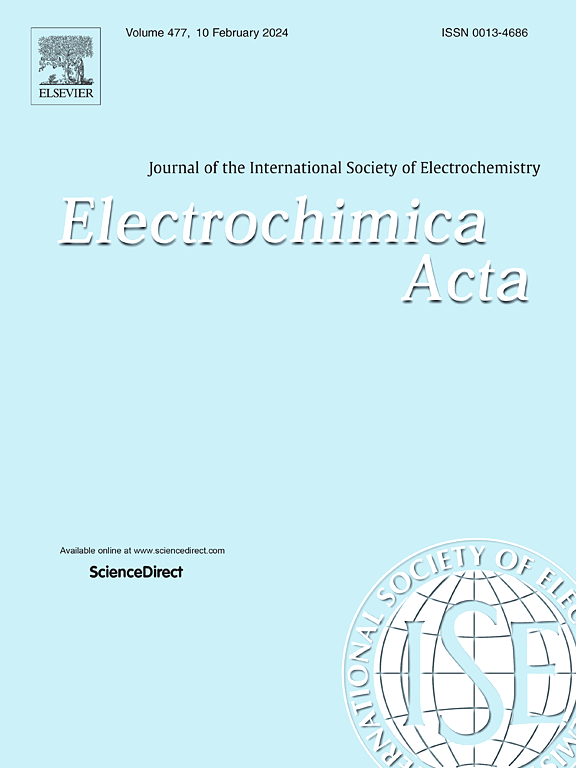A study on the evolution of hydrothermally synthesized MoS2 on thermal annealing and development of novel MoS2-MoO3 hybrid nanostructure for supercapacitor applications
IF 5.5
3区 材料科学
Q1 ELECTROCHEMISTRY
引用次数: 0
Abstract
The electrochemical capacitor also known as supercapacitor is a high-performance energy storage device with exceptional properties. We report the evolution of structural, morphological, optical, and thermal properties of MoS2 on thermal annealing along with its supercapacitor study. The pristine MoS2 is synthesized via the hydrothermal method at 200°C and the material is annealed in the presence of air at 250°C, 300°C, and 350°C. The 300°C annealed sample has shown a hybrid MoO3-xMoS2-y phase characterized by morphology of mixed flower-like and nano brick-like structures, marking the first time report of this novel formation. The evolution of the novel MoO3-xMoS2-y phase can be attributed to the intervention of lattice and interstitial oxygen species during synthesis. Electrochemical analysis is employed to study the supercapacitor nature of the materials. The electrochemical study revealed that the hybrid structure has a higher charge storage capacity than MoS2 or MoO3. The calculated specific capacitance from the galvanostatic charge-discharge curve of MoO3-xMoS2-y in 0.1M NaOH is observed to be 1.71mF/cm2, five times greater than other samples. Furthermore, the capacitor behavior of MoO3-xMoS2-y is studied in different electrolytes such as KOH, NaOH, and Na2SO4 at a concentration of 3M. The intercalation-assisted faradaic process is observed to be the major charge storage mechanism of the hybrid structure. Developing novel nanostructures with distinct properties is crucial for advancing supercapacitors to achieve optimal performance.关于水热合成的 MoS2 在热退火过程中的演变以及用于超级电容器的新型 MoS2-MoO3 混合纳米结构的开发的研究
电化学电容器又称超级电容器,是一种具有特殊性能的高性能储能装置。我们报告了 MoS2 在热退火过程中结构、形态、光学和热学特性的演变及其超级电容器的研究。原始 MoS2 是通过水热法在 200°C 下合成的,然后在空气存在下分别在 250°C、300°C 和 350°C 下退火。300°C 退火后的样品呈现出混合 MoO3-xMoS2-y 相,其形态特征为混合花状结构和纳米砖状结构,这是首次报道这种新型结构。新型 MoO3-xMoS2-y 相的演变可归因于合成过程中晶格和间隙氧物种的介入。电化学分析用于研究材料的超级电容器性质。电化学研究表明,混合结构比 MoS2 或 MoO3 具有更高的电荷存储容量。根据 MoO3-xMoS2-y 在 0.1M NaOH 中的电静态充放电曲线计算得出的比电容为 1.71mF/cm2,是其他样品的五倍。此外,还研究了 MoO3-xMoS2-y 在 KOH、NaOH 和 Na2SO4 等浓度为 3M 的不同电解质中的电容器行为。据观察,插层辅助法拉第过程是混合结构的主要电荷存储机制。开发具有独特性能的新型纳米结构对于推动超级电容器实现最佳性能至关重要。
本文章由计算机程序翻译,如有差异,请以英文原文为准。
求助全文
约1分钟内获得全文
求助全文
来源期刊

Electrochimica Acta
工程技术-电化学
CiteScore
11.30
自引率
6.10%
发文量
1634
审稿时长
41 days
期刊介绍:
Electrochimica Acta is an international journal. It is intended for the publication of both original work and reviews in the field of electrochemistry. Electrochemistry should be interpreted to mean any of the research fields covered by the Divisions of the International Society of Electrochemistry listed below, as well as emerging scientific domains covered by ISE New Topics Committee.
 求助内容:
求助内容: 应助结果提醒方式:
应助结果提醒方式:


